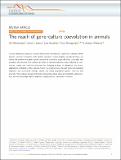Files in this item
Influence of resonant absorption on the generation of the Kelvin-Helmholtz instability
Item metadata
| dc.contributor.author | Antolin, Patrick | |
| dc.contributor.author | Van Doorsselaere, Tom | |
| dc.date.accessioned | 2019-06-06T15:30:01Z | |
| dc.date.available | 2019-06-06T15:30:01Z | |
| dc.date.issued | 2019-06-04 | |
| dc.identifier | 259224470 | |
| dc.identifier | 204b011b-c9ba-4975-aeff-564b20af5bbb | |
| dc.identifier | 000470168500002 | |
| dc.identifier | 85068534567 | |
| dc.identifier.citation | Antolin , P & Van Doorsselaere , T 2019 , ' Influence of resonant absorption on the generation of the Kelvin-Helmholtz instability ' , Frontiers in Physics , vol. 7 , 85 . https://doi.org/10.3389/fphy.2019.00085 | en |
| dc.identifier.issn | 2296-424X | |
| dc.identifier.other | RIS: urn:58EEB0F62954C3ABECA95D892B2DCFA3 | |
| dc.identifier.uri | https://hdl.handle.net/10023/17836 | |
| dc.description | PA acknowledges funding from his STFC Ernest Rutherford Fellowship (No. ST/R004285/1). TVD was funded by GOA-2015-014 (KU Leuven). This project has received funding from the European Research Council (ERC) under the European Union's Horizon 2020 research and innovation programme (grant agreement No. 724326). | en |
| dc.description.abstract | The inhomogeneous solar corona is continuously disturbed by transverse MHD waves. In the inhomogeneous environment of coronal flux tubes, these waves are subject to resonant absorption, a physical mechanism of mode conversion in which the wave energy is transferred to the transition boundary layers at the edge between these flux tubes and the ambient corona. Recently, transverse MHD waves have also been shown to trigger the Kelvin-Helmholtz instability (KHI) due to the velocity shear flows across the boundary layer. Also, continuous driving of kink modes in loops has been shown to lead to fully turbulent loops. It has been speculated that resonant absorption fuels the instability by amplifying the shear flows. In this work, we show that this is indeed the case by performing simulations of impulsively triggered transverse MHD waves in loops with and without an initially present boundary layer, and with and without enhanced viscosity that prevents the onset of KHI. In the absence of the boundary layer, the first unstable modes have high azimuthal wavenumber. A boundary layer is generated relatively late due to the mixing process of KHI vortices, which allows the late onset of resonant absorption. As the resonance grows, lower azimuthal wavenumbers become unstable, in what appears as an inverse energy cascade. Regardless of the thickness of the initial boundary layer, the velocity shear from the resonance also triggers higher order azimuthal unstable modes radially inwards inside the loop and a self-inducing process of KHI vortices occurs gradually deeper at a steady rate until basically all the loop is covered by small-scale vortices. We can therefore make the generalisation that all loops with transverse MHD waves become fully turbulent and that resonant absorption plays a key role in energising and spreading the transverse wave-induced KHI rolls all over the loop. | |
| dc.format.extent | 16 | |
| dc.format.extent | 4232951 | |
| dc.language.iso | eng | |
| dc.relation.ispartof | Frontiers in Physics | en |
| dc.subject | Magnetohydrodynamics (MHD) | en |
| dc.subject | Sun: activity | en |
| dc.subject | Sun: corona | en |
| dc.subject | Sun: oscillations | en |
| dc.subject | Resonant absorption | en |
| dc.subject | Instabilities | en |
| dc.subject | QB Astronomy | en |
| dc.subject | QC Physics | en |
| dc.subject | NDAS | en |
| dc.subject.lcc | QB | en |
| dc.subject.lcc | QC | en |
| dc.title | Influence of resonant absorption on the generation of the Kelvin-Helmholtz instability | en |
| dc.type | Journal article | en |
| dc.contributor.sponsor | Science & Technology Facilities Council | en |
| dc.contributor.institution | University of St Andrews. Applied Mathematics | en |
| dc.identifier.doi | 10.3389/fphy.2019.00085 | |
| dc.description.status | Peer reviewed | en |
| dc.identifier.grantnumber | ST/R004285/1 | en |
This item appears in the following Collection(s)
Items in the St Andrews Research Repository are protected by copyright, with all rights reserved, unless otherwise indicated.

